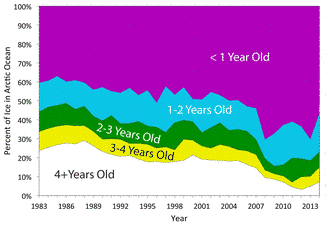Last week brought news of yet another alarming season for sea ice in the Arctic. The National Snow and Ice Data Center announced the Arctic sea ice coverage for winter was the fifth lowest maximum on record. The extent of ice was more than 280,000 square miles below the 30-year average for 1981-2010. That’s an area just bigger than the size of Texas missing.
Sea ice – the frozen crust of the ocean that grows to about 3 feet thick in a season – begins to grow in the autumn and peaks in early spring. Now, I’ve written earlier blogs about why summer sea ice decline should be front page news and the role of the Arctic in climate. So what’s up with winter? The peak this year was low again, despite a late season surge of growth in March. In fact, winter sea ice extent in the Arctic has been below average every winter for at least the last decade, as you can see on this interactive graph.
Sea ice decline is shown dramatically in an animation screened recently at the American Association for the Advancement of Science (AAAS) meeting in Chicago.
The amount of multi-year sea ice in the Arctic has declined over the last 25 years. The bright white ice is the oldest thickest sea ice. Source: NOAA/Climate.gov and Mark Tschudi, CCAR, University of Colorado.
Winter sea ice decline should also be front page news. Of more significance than the areal extent is the fact that the Artic is losing old and thick sea ice. Old sea ice is generally much thicker than young sea ice, and thus contributes more overall to the total volume of the Arctic ice pack. Think of it like ice cubes in your drink. If you have a glass with deep ice cubes floating at the top, your drink will stay cooler longer and the ice will take longer to melt. If you have very shallow ice cubes floating on the top that nevertheless cover the same area, they will melt quicker simply because there is less ice volume.

In the 1980s, about 25% of the Arctic sea ice was estimated to be multi-year ice older than 4 years – but this year around 7% is that old. Younger and thinner sea ice is far less likely to survive the warmer summer. Source: NSIDC, and M. Tschudi, University of Colorado
Younger and thinner sea ice is far less likely to survive the warmer summers, just like slim ice cubes in your drink melt out quickly. For thousands of years, Arctic sea ice has built up in the winter and decayed in the summer, but not all of it melted out each year.
The ice that survives the summer is added to during the next winter, forming what is known as “multi-year” sea ice, which can reach more than 12 feet thick and can be over five years in age. But the dramatic decline of summer sea ice in the Arctic over the last decade has led to a decrease in multi-year thick ice.
In the 1980s, about 25 percent of the Arctic sea ice was estimated to be older than four years in age. But for every year since 2008, less than 10 percent of the sea ice in the Arctic is older than 4 years.
The Arctic is now an ocean of rapidly melting thin ice cubes.
